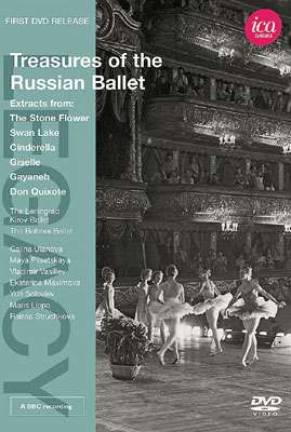Legendary Russian Dancers Featured In "Treasures Of The Russian Ballet"

Bolshoi and Kirov vitality preserved Legendary Russian dancers show why they are legends in the new DVDTreasures of the Russian Ballet(ICA Classics/Naxos). It contains performances by Moscow's Bolshoi Ballet and (then) Leningrad's Kirov filmed by the BBC in London from 1956 to 1963, some on stage, some in the television studio. The longest excerpt in the anthology is Act 1 of Yuri Grigorovich'sThe Stone Flower, recorded during the Kirov's debut London season in the summer of 1961. Yuri Soloviev was 20 and Alla Sizova 21 at the time they were filmed here. But for once we're privy to young dancers not trying to merchandize their youth, but instead experiencing it. They create a portrait of young love that is irrefutable not only visually but artistically. Alla Osipenko dances the role of a mythical mountain dweller who bewitches Soloviev's character. Her role is filled with jumps to suggest ferality and brittle full stops enabling her unsurpassed arabesque to imprint itself. The preserved performance is a fitting birthday tribute to Osipenko, who turned 80 last week. The Bolshoi's Raissa Struchkova and Maya Plisetskaya: call them the Life Force ballerinas. Filmed here in excerpts fromCinderella, Struchkova is a quintessential embodiment of the vitality for which the Bolshoi was celebrated. Dancing Kitri inDon Quixote, Plisetskaya transcends soubrette clichés-or is what she's really doing instead a revelatory distillation of the charm and power of the archetype? Her partner, Vladimir Vasiliev, like Soloviev, and the Bolshoi's Maris Liepa and Mikhail Lavrovsky, show in this DVD the way they revealed to the world new possibilities for male ballet expression. Galina Ulanova was a product of the Kirov but was transferred to the Bolshoi at the end of World War II. At 46, Ulanova is quite astonishing in the White Swan adagio fromSwan Lake, captured during the company's debut season in London in 1956. Her performance is technically imperfect by the standards of her day or ours, and yet at any calendar age or historical epoch Ulanova would be the kind of artist about whom quibbles are irrelevant. Every step she takes demonstrates a personal and masterly way of shaping a step, a phrase, a role, a larger metaphor. Indeed, it's not possible here to mention, let alone do justice to all the great performances in this collection-let me just say that everything on it is crucial viewing! Read more by Joel Lobenthal at[Lobenthal.com](http://www.lobenthal.com/)